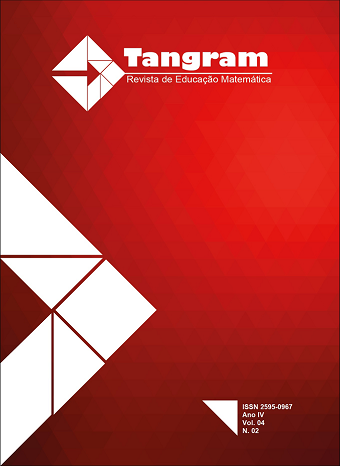Una propuesta de adaptación del juego Dixit empleando tarjetas WODB con contenido matemático
DOI:
https://doi.org/10.30612/tangram.v4i2.14533Keywords:
Juegos en matemáticas, Lenguaje, WODBAbstract
Los WODB (Which One Doesn’t Belong?) favorecen el uso del lenguaje matemático, permitiendo que los estudiantes reflexionen sobre las propiedades de los objetos matemáticos que observan en ellas. Considerando el potencial educativo de los juegos en todas las áreas curriculares y, en particular, en matemáticas, en este trabajo se desarrolla una propuesta didáctica para matemáticas en educación primaria adaptando el juego de mesa Dixit con el recurso WODB. En la dinámica que se crea, los alumnos tienen que clasificar a través de su lenguaje los elementos de las tarjetas WODB destacando propiedades que los hagan únicos, pero intentando evitar las más evidentes o cuidando su formulación. La experiencia que se llevó a cabo con alumnos de 11-12 años ha permitido valorar este recurso a partir de sus expresiones lingüísticas, sugiriendo su utilidad tanto como evaluación inicial, como actividad para desarrollar el uso del lenguaje.Downloads
References
Calvo, C. y Obrador, D. (2016). De WODB fins a QUELI: reflexionar, deduir i defensar arguments a l’ aula de matemàtiques. Congrés Catalá d’Educació Matemática, 1–10. Barcelona.
Chen L., Van Dooren W. y Verschaffel L. (2015). Enhancing the development of chinese fifth-graders’ problem-posing and problem-solving abilities, beliefs, and attitudes: A design experiment. En F.Singer, N. Ellerton y J. Cai (Eds.) Mathematical problem posing. Research in mathematics education. New York, NY: Springer.
Gutiérrez, Á. y Jaime, A. (2012). Reflexiones sobre la enseñanza de la geometría en primaria y secundaria. TED: Tecné, Episteme y Didaxis, 32, 55–70.
Jaime, A. y Gutiérrez, Á. (1990). Una propuesta de fundamentación para la enseñanza de la geometría: El modelo de Van Hiele. Teoría y Práctica En Educación Matemática (Colección Ciencias de La Educación N° 4), 298–384.
Howse, T.D. y Howse, M. E. (2014). Linking the Van Hiele Theory to Instruction. Teaching Children Mathematics, 21(5), 304–313.
Hunter, C. (2018). Alike and Different: Which One Doesn’ t Belong? and More. Vector, 60(1), 17–20.
Kafai, Y. B., Franke, M. L., Ching, C. C. y Shih, J. C. (1998). Game design as an interactive learning environment for fostering students’ and teachers’ mathematical inquiry. International Journal of Computers for Mathematical Learning, 3(2), 149-184.
Milinković J. (2015). Conceptualizing problem posing via transformation. En F.Singer, N. Ellerton y J. Cai (Eds.) Mathematical Problem posing. Research in mathematics education. New York, NY: Springer.
Ricart, M., Beltrán-Pellicer, P. y Estrada, A. (2019). Actividad scaffolding en geometría para desarrollar habilidades de argumentación y clasificación en futuros maestros de Educación Infantil. En J. M. Marbán, M. Arce, A. Maroto, J. M. Muñoz-Escolano y Á. Alsina (Eds.), Investigación en Educación Matemática XXIII (pp. 503-512). Valladolid: SEIEM.
Van Hiele, P.M. (1986). Structure and insight. A theory of mathematics education. Londres, G. Bretaña: Academic Press.
Downloads
Published
How to Cite
Issue
Section
License
Authors must accept the publication rules when submitting the journal, as well as agree to the following terms:
(a) The Editorial Board reserves the right to make changes to the Portuguese language in the originals to maintain the cultured standard of the language, while respecting the style of the authors.
(b) Authors retain the copyright and grant the journal the right to first publication, with the work simultaneously licensed under the Attribution-NonCommercial-ShareAlike 3.0 Brazil (CC BY-NC-SA 3.0 BR) that allows: Share - copy and redistribute the material in any medium or format and Adapt - remix, transform, and create from the material. CC BY-NC-SA 3.0 BR considers the following terms:
- Attribution - You must give the appropriate credit, provide a link to the license and indicate whether changes have been made. You must do so under any reasonable circumstances, but in no way that would suggest that the licensor supports you or your use.
- NonCommercial - You may not use the material for commercial purposes.
- Sharing - If you remix, transform, or create from material, you must distribute your contributions under the same license as the original.
- No additional restrictions - You may not apply legal terms or technological measures that legally restrict others from doing anything that the license permits.
(c) After publication, authors are allowed and encouraged to publish and distribute their work online - in institutional repositories, personal page, social network or other scientific dissemination sites, as long as the publication is not for commercial purposes.


